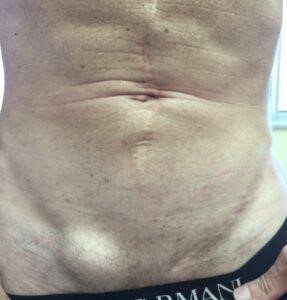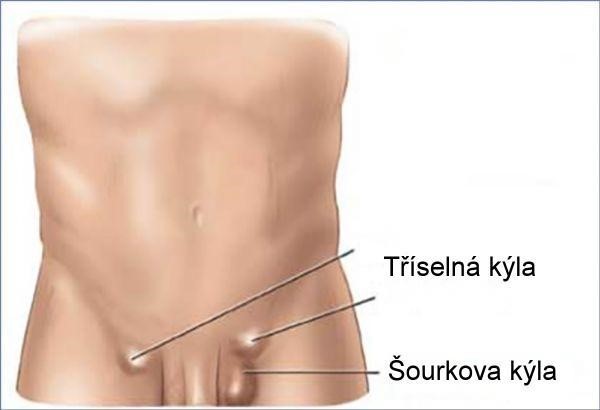This is a hernia located in the area of the right or left groin, or bilaterally. A hernia is an opening (hernial orifice) in the abdominal wall through which internal organs (most commonly abdominal fat or the intestine) bulge out from the abdominal cavity into the subcutaneous tissue. It occurs in areas where the abdominal wall is weakened. In the groin of men, blood vessels and the spermatic cord pass through a small opening in both groins to the testicle. In women, the same area is penetrated by a small abdominal wall opening through which the uterine ligament, which supports the uterus, passes. When this opening enlarges, something that should not be bulging starts to protrude.

The patient may feel or observe a lump in the groin, which is usually soft and can often be pushed back into the abdomen, but then it pops out again. The hernia may be tender, but it doesn’t have to be. Over time, the hernia only increases in size and does not resolve on its own. If left untreated, it can grow to large sizes and, in men, may extend into the scrotum.

The exact cause is not clear, however, the development of an inguinal hernia is contributed to by lifting heavy objects and congenital weakness of the connective tissue or anatomical predisposition. It often occurs in patients with a family history, either in parents or children.
A hernia is usually not painful and generally does not cause significant problems, but it can be tender and may provoke a burning sensation or discomfort. Over time, it increases in size. If the hernia is painful, its contents are likely trapped in the opening. This is a warning sign. A severely painful hernia that cannot be pushed back into the abdomen indicates incarceration. There may be pain throughout the abdomen, vomiting, and a cessation of bowel movements and gas. The incarceration of a hernia is caused by the contents, such as the intestine, getting stuck in the opening (hernial ring), leading to the trapped part of the intestine starting to die. This is an acute condition requiring urgent surgery to prevent intestinal necrosis. If you experience the above symptoms, seek medical attention immediately.
If a hernia occurs, it will not resolve on its own and may only get larger. The only definitive solution is surgery. The principle of the operation is to pull back what is protruding from the abdominal cavity into the abdominal cavity and to stitch or place a mesh over the opening (hernial ring). An inguinal hernia belt is generally not recommended, as it can cause abrasions and moisture buildup; however, it may help some patients until they can undergo surgery. However, the belt will not cure the hernia!
In our facility, we primarily perform surgeries laparoscopically. This involves an operation under general anesthesia, during which we access the abdominal cavity through three small incisions. The abdomen is inflated with gas (CO2), and the surgery is captured by a camera that projects the images onto a screen. The part that protrudes from the abdominal cavity is released and returned to the cavity, and a mesh (made of polypropylene) sized between 15×10 to 17×12 cm is placed over the opening (hernial orifice), which is then secured with absorbable screws as needed. The operation typically lasts around 30-45 minutes for a unilateral hernia and about 60-70 minutes for a bilateral hernia. In very ill and elderly patients, the surgery can be performed under local anesthesia; however, this procedure is not laparoscopic but rather a traditional open surgery. The principle is similar—the protruding intestine is released and returned to the abdomen, and the opening (hernial orifice) is either sewn up or covered with a mesh.
Video of the surgical procedure:
First, a consultation with a doctor in the surgical outpatient clinic is necessary. If an inguinal hernia is confirmed, a surgery date will be scheduled. On the agreed date, the patient must arrive fasting and with a preoperative examination from their general practitioner. The surgery takes place on the same day. After the operation, the patient receives pain medication as needed, and a few hours post-surgery, they can have something to drink and possibly a light snack. Due to the general anesthesia, hospitalization continues for one night, and the patient is discharged in the morning. They return for a follow-up approximately 10 days later, usually without significant issues, and the stitches are removed. We also recommend avoiding heavy physical activity for 4-6 weeks.
The vast majority of surgeries are performed without complications; however, they can occur. The most common complications include swelling at the site of the hernia or bruising, both of which can extend to the scrotum in men. There may also be sensitivity in the testicle. Sometimes, fluid can accumulate at the site of the original hernia, which may need to be drained with a syringe during a follow-up visit, occasionally requiring repeated drainage. Very rarely, a hernia may recur after surgery (recurrence). However, this can be re-operated on laparoscopically. While this is a more challenging procedure for the surgeon, for the patient, the process is generally similar to the first surgery.